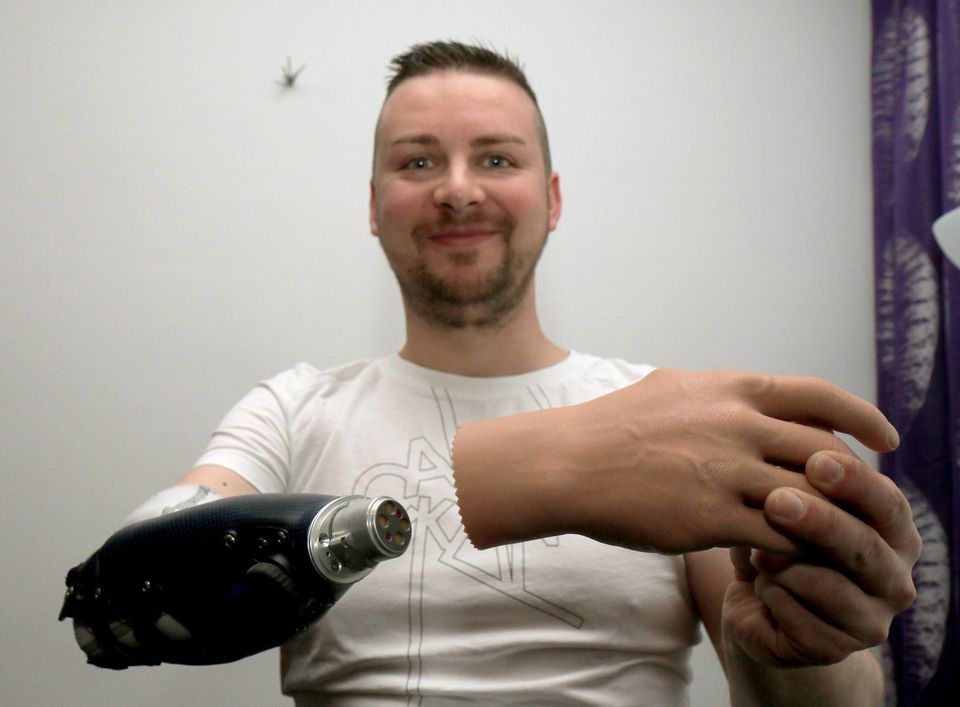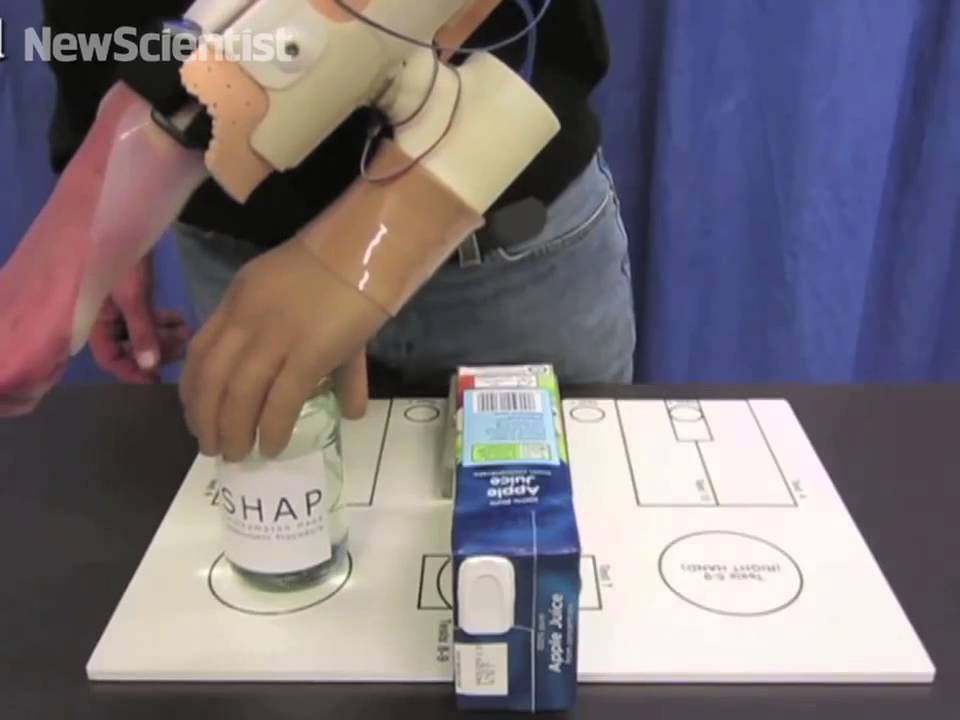It looks like you're using an Ad Blocker.
Please white-list or disable AboveTopSecret.com in your ad-blocking tool.
Thank you.
Some features of ATS will be disabled while you continue to use an ad-blocker.
6
share:
From NEW SCIENTIST.com
Three people with paralysed arms had their hands amputated and replaced by prosthetic ones that they control with their mind
Preparing the body

Milorad Marinkovic with his bionic arm
Too complex
Function restored
If it was my choice and I had a similar issue I would do the same..They have working hands AGAIN! The ammount of freedom given to these men must be overwhelming..I fully support this. "GO SCIENCE"!
Three people with paralysed arms had their hands amputated and replaced by prosthetic ones that they control with their mind
Three men with serious nerve damage had their hands amputated and replaced by prosthetic ones that they can control with their minds.
Bionic arm trumps flesh after elective amputation
The procedure, dubbed "bionic reconstruction", was carried out by Dr. Oskar Aszmann at the Medical University of Vienna, Austria.
The men had all suffered accidents which damaged the brachial plexus – the bundle of nerve fibres that runs from the spine to the hand. Despite attempted repairs to those nerves, the arm and hand remained paralysed.
"But still there are some nerve fibres present," says Aszmann. "The injury is so massive that there are only a few. This is just not enough to make the hand alive. They will never drive a hand, but they might drive a prosthetic hand."
This approach works because the prosthetic hands come with their own power source. Aszmann's patients plug their hands in to charge every night. Relying on electricity from the grid to power the hand means all the muscles and nerves need do is send the right signals to a prosthetic.
Preparing the body
Before the operation, Aszmann's patients had to prepare their bodies and brains. First he transplanted leg muscle into their arms to boost the signal from the remaining nerve fibres. Three months later, after the nerves had grown into the new muscle, the men started training their brains.
First they practised activating the muscle using an armband of sensors that picked up on the electrical activity. Then they moved on to controlling a virtual arm. Finally, Aszmann amputated their hands, and replaced them with a standard prosthesis under the control of the muscle and sensors.
"I was impressed and first struck with the surgical innovation," says Dustin Tyler of the Louis Stokes Veterans Affairs Medical Center in Cleveland, Ohio. "There's something very personal about having a hand; most people will go to great lengths to recover one, even if it's not very functional. It's interesting that people are opting for this."
While Aszmann's approach uses a grafted muscle to relay signals from the brain to a prosthesis, others are taking a more direct route, reading brain waves directly and using them to control the hand. A team at the University of Pittsburgh, Pennsylvania, has used a brain implant to allow a paralysed woman to control a robotic arm using her thoughts alone.

Milorad Marinkovic with his bionic arm
Too complex
Tyler says one advantage of an elective amputation is that it allows the surgeons to plan exactly where the cut will be made, and how the prosthesis can graft to the wearer's skeleton for enhanced stability.
Even if nerve and muscle function could be completely restored in the arm, biological hands are too complex for surgeons like Aszmann to rewire. The muscles in our hands have the highest density of nerves in the body, and the interplay of tendons, muscles and ligaments means that even small defects can prevent a hand functioning properly.
A prosthetic hand is simpler, and easier to work with. "I'm not sure we need to replace hands perfectly," says Tyler. "You may not play the piano yet, so rather than replacing the hand, the goal is to make you forget you lost it."
For Aszmann's patients, that simple, functional prosthetic hand works better than their biological one. After the transplant, all three were able to pick up a ball, pour water from a jug and do up buttons.
Function restored
The patients' scores on a range of limb function tests also improved after the surgery. On a test called the Southampton Hand Assessment Procedure they improved their average score from 9 out of 100 to 65, where 100 is a normally functioning hand.
Although Aszmann's procedure gives hand function back to his patients, he can't yet give them back their sense of touch. "There are about 70,000 nerve fibres to a normal hand, and the majority of these are sensory fibres carrying hand-to-brain information," he says. "Only 10 per cent are motor fibres."
"Sensation and touch is what connects us to the world," says Tyler. He's working on a prototype prosthetic arm that provides hand to brain information, not just motor control. The current version uses wires to deliver electronic stimulation to nerves in the arm, but Tyler says his team will have a fully implantable wireless version in three or four years.
Even then, our technological alternatives to the hand will remain crude compared with fully functional human hands. "There's an immense interplay that makes the hand what it is," says Aszmann. "It's a fascinating organ."
"We're rethinking the wiring of the body," says Tyler.
If it was my choice and I had a similar issue I would do the same..They have working hands AGAIN! The ammount of freedom given to these men must be overwhelming..I fully support this. "GO SCIENCE"!
edit on 2/25/2015 by DjembeJedi because: (no reason given)
edit on
2/25/2015 by DjembeJedi because: (no reason given)
edit on 2/25/2015 by DjembeJedi because: (no reason given)
a reply to: DjembeJedi
The early stages of the 6 million dollar man. I remember growing up watching that show and always thought it would be so cool if they could actually create super human bionic limbs. Now it seems like it's staring to become a reality. I wouldn't be surprised it they tweaked the power of the bionic hands so they would be much stronger than a human. Replacing legs with bionics will really make wheel chairs obsolete. We will than see super human bionic speed!
I wouldn't be surprised if fiction becomes a reality and they recruit maimed soldiers to become bionic elite soldiers or spies. Steve Austin spies will become a reality. The next thing we'll have to wait and see is the bionic eye.
The early stages of the 6 million dollar man. I remember growing up watching that show and always thought it would be so cool if they could actually create super human bionic limbs. Now it seems like it's staring to become a reality. I wouldn't be surprised it they tweaked the power of the bionic hands so they would be much stronger than a human. Replacing legs with bionics will really make wheel chairs obsolete. We will than see super human bionic speed!
I wouldn't be surprised if fiction becomes a reality and they recruit maimed soldiers to become bionic elite soldiers or spies. Steve Austin spies will become a reality. The next thing we'll have to wait and see is the bionic eye.
a reply to: WeRpeons
"They" are on it! Man Gets Bionic Eye
btw..I LOVED that show when I was a Kid
The next thing we'll have to wait and see is the bionic eye.
"They" are on it! Man Gets Bionic Eye
btw..I LOVED that show when I was a Kid
a reply to: DjembeJedi
COOL! That's awesome! It's nice to see that the blind have hope that someday they can see again.
That show was one of my favorites too!
"They" are on it! Man Gets Bionic Eye
btw..I LOVED that show when I was a Kid
COOL! That's awesome! It's nice to see that the blind have hope that someday they can see again.
That show was one of my favorites too!
More awesome android wonderfulness. I still think cloning yourself for body parts is the best way to go and you know what, I'm fairly sure that every
billionaire or top tier wealthy person already has a clone in an incubator exactly for this purpose. I know I would.
originally posted by: WeRpeons
a reply to: DjembeJedi
The early stages of the 6 million dollar man.
deadline.com...
On topic:
If it really is wired to the brain, what happens when you want to strangle your boss..?
It would be nice to put that to the test.
It is always wonderful to see such things made, but even with medical coverage and the high cost of deductibles and whatever, who will be able to
afford it? My husband has a prosthetic leg that is electronic and bends at the knee and even with medical coverage it cost him a fortune.
new topics
-
Former DOJ charged with defrauding Rep. Matt Gaetz’s family over sex-crimes investigation
Propaganda Mill: 3 hours ago
top topics
-
Former DOJ charged with defrauding Rep. Matt Gaetz’s family over sex-crimes investigation
Propaganda Mill: 3 hours ago, 10 flags -
Swedish Minister for Gender Equality is Seeking Treatment for Phobia of Bananas
Politicians & People: 14 hours ago, 7 flags -
Satanic ‘Little Season’ of Deception.. Awaken to the Handiwork of the Creator.
ATS Skunk Works: 14 hours ago, 4 flags -
USA-BIDEN and CHINA-Xi Agree Not To Let Artificial Intelligence Decide Nuclear Weapons Use.
World War Three: 15 hours ago, 3 flags
active topics
-
How can you defend yourself when the police will not tell you what you did?
Posse Comitatus • 97 • : covent -
Priests of the Temple of Syrinx
Social Issues and Civil Unrest • 48 • : Solvedit -
Former DOJ charged with defrauding Rep. Matt Gaetz’s family over sex-crimes investigation
Propaganda Mill • 6 • : fringeofthefringe -
The Reactionary Conspiracy 6. Modus Operandi II
General Conspiracies • 127 • : MarxistDebunker2 -
Bucks County commissioners vote to count illegal ballots in Pennsylvania recount
2024 Elections • 23 • : Kaiju666 -
The Trump effect 6 days after 2024 election
2024 Elections • 151 • : fringeofthefringe -
Post A Funny (T&C Friendly) Pic Part IV: The LOL awakens!
General Chit Chat • 7779 • : baddmove -
The mysterious death of Aileen Conway
General Chit Chat • 12 • : CarlLaFong -
I’m Looking for Information on the Light We See at Death.
The Gray Area • 65 • : whereislogic -
President-elect TRUMP Picks MATT GAETZ for his ATTORNEY GENERAL - High Level PANIC Ensues.
2024 Elections • 94 • : RickinVa
6

